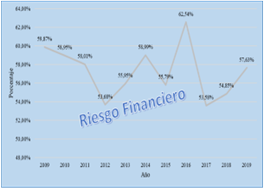Probability of business bankruptcy in theconstruction sector of Ecuador: Period 2011 – 2020
DOI:
https://doi.org/10.17981/econcuc.44.2.2023.Econ.2Keywords:
Bankruptcy, Construction, Logistic regression, Probi, Predictive capacityAbstract
In business decisions, it is necessary to determine which are the variables that explain the probability of bankruptcy in order to make predictions about them in a second stage. The objective of this research work is to determine the probability of failure of companies in the construction sector in Ecuador. In order to achieve the goal, the logistic regression model and the Probit model were applied, which are binary discrete choice models. Among the important findings, it can be said that the variables that explain the probability of business bankruptcy in the sector are the size of the company, the level of indebtedness, liquidity, profitability and net income. In addition, the predictive capacity of the model was verified under different metrics such as sensitivity, specificity and later the ROC curve. In general, the Probit model gives a better predictive capacity of the model.
Downloads
References
Ahn, B. S., Cho, S. S. & Kim, C. Y. (2000). Integrated methodology of rough set theory and artificial neural network for business failure prediction. Expert Systems with Applications, 18(2), 65–74. https://doi.org/10.1016/S0957-4174(99)00053-6
Altman, E. (1968). Financial ratios, discriminant analysis and the prediction of corporate bankruptcy. The Journal of Finance, 23(4), 589–609. https://doi.org/10.2307/2978933
Altman, E., Haldeman, R. & Narayanan, P. (1977). ZETATM analysis A new model to identify bankruptcy risk of corporations. Journal of Banking and Finance, 1(1), 29–54. https://doi.org/10.1016/0378-4266(77)90017-6
Ariza Dau, M., Acosta Rueda, K. y Altamar, L. (2016). Aplicación de los Modelos de Respuesta Binaria a los Determinantes de la Demanda de Postgrado en Colombia. Escenarios, 14(1), 7–18. https://doi.org/10.15665/esc.v14i1.874
Beaver, W. (1966). Financial Ratios as Predictors of Failure. Journal of Accounting Research, 4, 71–111. https://doi.org/10.2307/2490171
Bermeo, D. y Armijos, J. (2021). Predicción de quiebra bajo el modelo Z2 Altman en empresas de construcción de edificios residenciales de la provincia del Azuay. Revista Economía, 33, 48–63. https://doi.org/10.25097/rep.n33.2021.03
Bermúdez, N. y Bravo, A. (2019). Modelo Predictivo de los Determinantes del Cierre Empresarial de las MIPYMES en el Ecuador Período 2007-2016. X - Pedientes Económicos, 3(5), 78–93. Disponible en https://ojs.supercias.gob.ec/index.php/X-pedientes_Economicos/article/view/32
Bravo, F. y Pinto, C. (2008). Modelos predictivos de la probabilidad de insolvencia en microempresas chilenas. Contaduría Universidad de Antioquia, (53), 13–52. https://doi.org/10.17533/udea.rc.2175
Cortes, M., Saavedra, M. & Palacios, P. (2021). Análisis del fracaso de las MiPyME franquiciantes en México. Un crecimiento cuestionable del sector. Revista Perspectiva Empresarial, 7(2), 36–52. https://doi.org/10.16967/23898186.651
Cruz, S., Gavira, N. & García, R. (2017). Eficiencia de los modelos Poisson y Logístico en la asignación de probabilidades de incumplimiento a empresas mineras mexicanas. Revista Mexicana de Economía y Finanzas, 12(1), 1–21. http://dx.doi.org/10.21919/remef.v12i1.9
Cueva, D. F., Cortes, S., Tapia, R., Tabi, W., Torres, J., Maza, C., Uyaguari, K. y González, M. (2017, junio). Fragilidad Financiera de las Empresas - Estimación de un Modelo probabilístico LOGIT y PROBIT: Caso Ecuatoriano. Conferencia presentada en la XII Conferencia Ibérica de Sistemas y Tecnologías de la Información, CISTI, Lisbon, Portugal. https://doi.org/10.23919/CISTI.2017.7975927
Deakin, E. (1972). Research Reports A Discriminant Analysis of Predictors of Business Failure. Journal of Accountin Research, 10(1), 167–179. https://doi.org/10.2307/2490225
Dupleix, M. (2021). La teoría efectual y el fracaso empresarial. Innovar, 31(81), 139–154. https://doi.org/10.15446/innovar.v31n81.95581
FitzPatrick, P. (1932). Average Ratios of Twenty Representative Industrial Failures *. The Certified Public Account, 13–18.
Gujarati, D. y Porter, D. (2010). Econometría (5 ed.). México, D.F.: McGraw-Hill.
Kliestik, T., Misankova, M., Valaskova, K. & Svabova, L. (2018). Bankruptcy Prevention: New Effort to Reflect on Legal and Social Changes. Science and Engineering Ethics, 24(2), 791–803. https://doi.org/10.1007/s11948-017-9912-4
Krishnasami, J. (2012). Financial Risk: Impact on Debt-Equity Mix. SCMS Journal of Indian Management, 9(1), 43–59. Available from https://www.scms.edu.in/uploads/journal/January%20-%20March%202012.pdf
Kücher, A., Mayr, S., Mitter, C., Duller, C. & Feldbauer-Durstmüller, B. (2020). Firm age dynamics and causes of corporate bankruptcy: age dependent explanations for business failure. Review of Managerial Science, 14(3), 633–661. https://doi.org/10.1007/s11846-018-0303-2
Lennox, C. (1999). Identifying failing companies: A reevaluation of the Logit, Probit and DA approaches. Journal of Economics and Business, 51(4), 347–364. https://doi.org/10.1016/s0148-6195(99)00009-0
Lin, T.-H. (2009). A cross model study of corporate financial distress prediction in Taiwan: Multiple discriminant analysis, Logit, Probit and neural networks models. Neurocomputing, 72(16–18), 3507–3516. https://doi.org/10.1016/j.neucom.2009.02.018
Martínez, H., Cazallo, A., Meñaca, I. y Uribe, C. (2020). Desempeño financiero de las empresas minoristas de alimentos y bebidas en Barranquilla - Colombia. Revista de Ciencias Sociales, 26(1), 144–158. https://doi.org/10.31876/rcs.v26i1.31316
Mittal, S. & Lavina. (2018). The Determinants of Financial Distress in Indian real estate and Construction industry. Gurukul Business Review, 14(2), 6–11. Available: https://gurukulbusinessreview.in/past-issues/
Navarrete, G. (2022). Organizaciones inteligentes y su incipiente incursión en la esfera turística. Una aproximación al estado del conocimiento. Telos Revista de Estudios Interdisciplinarios en Ciencias Sociales, 24(1), 100–122. https://doi.org/10.36390/telos241.07
Ogachi, D., Ndege, R., Gaturu, P. & Zoltan, Z. (2020). Corporate Bankruptcy Prediction Model, a Special Focus on Listed Companies in Kenya. Journal of Risk and Financial Management, 13(3), 1–14. https://doi.org/10.3390/jrfm13030047
Ohlson, J. A. (1980). Financial Ratios and the Probabilistic Prediction of Bankruptcy. Journal of Accounting Research, 18(1), 109–131. https://doi.org/10.2307/2490395
Pérez, G., González, C. y Lopera, C. (2013). Modelos de predicción de la fragilidad empresarial: aplicación al caso colombiano para el año 2011. Perfil de Coyuntura Económica, (22), 205–228. Disponible en https://revistas.udea.edu.co/index.php/coyuntura/article/view/20539
Rodríguez, C., Maté, M. y López, F. (2020). La proximidad geográfica en el contagio del fracaso empresarial en la pyme: Una aplicación empírica con el modelo Probit espacial. Estudios de Economía Aplicada, 34(3), 629–648. https://doi.org/10.25115/eae.v34i3.3063
Romero, F. (2013). Variables financieras determinantes del fracaso empresarial para la pequeña y mediana empresa en Colombia: análisis bajo modelo Logit. Pensamiento & Gestión, (34), 235–277. Disponible en https://rcientificas.uninorte.edu.co/index.php/pensamiento/article/view/5647
Romero, F., Melgarejo, Z. & Vera-Colina, M. (2015). Fracaso empresarial de las pequeñas y medianas empresas (pymes) en Colombia. Suma de Negocios, 6(13), 29–41. https://doi.org/10.1016/j.sumneg.2015.08.003
Singh, B. P. & Mishra, A. K. (2016). Re-estimation and comparisons of alternative accounting based bankruptcy prediction models for Indian companies. Financial Innovation, 2(1), 1–28. https://doi.org/10.1186/s40854-016-0026-9
Solomon, D. C. & Muntean, M. (2012). Assessment of Financial Risk in Firm’s Profitability Analysis. Economy Transdisciplinarity Cognition, 15(2), 58–67. Available from https://www.ugb.ro/etc/etc2012no2/11_Solomon,_Muntean_final.pdf
Spekman, R. E. & Davis, E. W. (2004). Risky business: Expanding the discussion on risk and the extended enterprise. International Journal of Physical Distribution and Logistics Management, 34(5), 414–433. https://doi.org/10.1108/09600030410545454
Supercias. (2020). Portal de información. Superintendencia de compañías valores y seguros. Disponible en https://appscvsmovil.supercias.gob.ec/portalInformacion/sector_societario.zul
Svabova, L., Michalkova, L., Durica, M. & Nica, E. (2020). Business failure prediction for Slovak small and medium-sized companies. Sustainability (Switzerland), 12(11), 1–14. https://doi.org/10.3390/su12114572
Támara, A. y Villegas, G. (2021). Influencia del entorno financiero, el entorno macroeconómico, la estructura organizacional y la transparencia en la quiebra empresarial. Contaduria y Administracion, 66(2), 1–23. https://doi.org/10.22201/fca.24488410e.2021.2618
Wu, W. W. (2010). Beyond business failure prediction. Expert Systems with Applications, 37(3), 2371–2376. https://doi.org/10.1016/j.eswa.2009.07.056
Zambrano, F., Sánchez, M. y Correa, S. (2021). Análisis de rentabilidad, endeudamiento y liquidez de microempresas en Ecuador. Retos, 11(22), 235–249. https://doi.org/10.17163/ret.n22.2021.03
Zmijweski, M. E. (1984). Methodological Issues Related to the Estimation of Financial Distress Prediction Models. Journal of Accounting Research, 22, 59–82. https://doi.org/10.2307/2490859

Downloads
Published
How to Cite
Issue
Section
License
Copyright (c) 2023 Marco Reyes Clavijo, Iván Orellana, Luis Pinos, Estefanía Cevallos, Luis Tonon

This work is licensed under a Creative Commons Attribution-NonCommercial-NoDerivatives 4.0 International License.
You are free to:
- Share — copy and redistribute the material in any medium or format
- The licensor cannot revoke these freedoms as long as you follow the license terms.
Under the following terms:
- Attribution — You must give appropriate credit , provide a link to the license, and indicate if changes were made . You may do so in any reasonable manner, but not in any way that suggests the licensor endorses you or your use.
- NonCommercial — You may not use the material for commercial purposes .
- NoDerivatives — If you remix, transform, or build upon the material, you may not distribute the modified material.
- No additional restrictions — You may not apply legal terms or technological measures that legally restrict others from doing anything the license permits.

 English
English
 Español (España)
Español (España)














